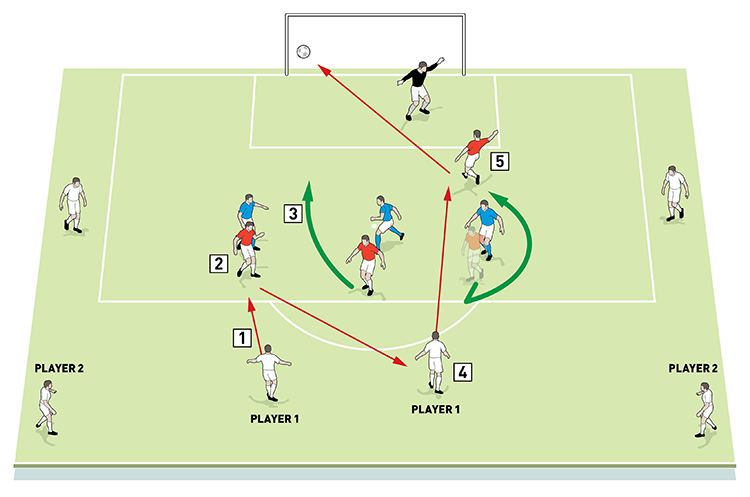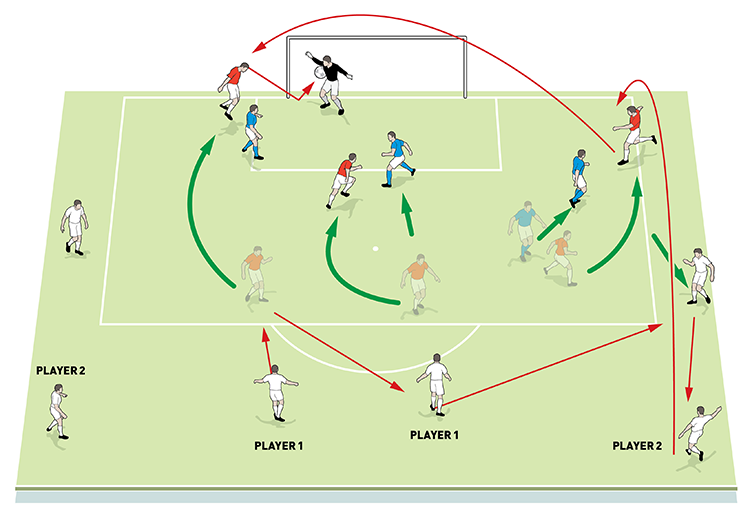




OUR BEST EVER OFFER - SAVE £100/$100
JOIN THE WORLD'S LEADING PROFESSIONAL DEVELOPMENT PROGRAMME
- 12 months membership of Elite Soccer
- Print copy of Elite Player & Coach Development
- Print copy of The Training Ground
You are viewing 1 of your 1 free articles
Play around the box
This session looks at attacking play around the box, movement within the box and delivery into it. It’s not unique but it is important for attacking play around the box, both in terms of movement and combination play. The quality of delivery is also important; no rockets into the box!
| Area | Use of half a pitch |
| Equipment | Balls, cones, goals |
| No. of Players | 12 |
| Session Time | 20mins |
This session looks at attacking play around the box, movement within the box and delivery into it. It’s not unique but it is important for attacking play around the box, both in terms of movement and combination play. The quality of delivery is also important; no rockets into the box!
We’d run this twice a week for six weeks before changing. We’d then return to it during the season.
What do I get the players to do?
The idea is to have 12 players (2 x 6), so you can easily change around. If you have more than 12 players, you can rotate the outside players but only have 3x3 in the box.
Player 1 starts the move by playing to a red or blue player. The player receiving the ball can play to his two team mates or back to an ‘outside player’.
If a defender wins the ball, they play to an outside player and their team becomes the attackers.
The coach can place outside players where he thinks is best - I particularly like players 2 (as shown in the diagram) to allow for soft, chipped balls in (no rockets).
The coach can also decide whether to play offside or not. When I coach 12 to 14-year-olds, I don’t watch for offside.
1

2. The receiving red is well marshaled
3. His team mate prepares to make a run
4. The ball is touched back and a through-pass made
5. The third attacker makes a sharp run and receives the pass to shoot at goal
2

What are the key things to look out for?
Whilst the session practises technique, it is intended to improve decision-making.
Those in the box should work with each other - they shouldn’t be in the same space. Attackers shouldn’t run towards outside players in straight lines - instead they should come off at an angle to try to receive on the turn or half-turn.
Attackers should avoid playing back to the same outside player who passed to them.
The technical aim of the attackers should be to receive the ball under pressure and create a goalscoring opportunity for themselves or a team mate.
For outside players, the most important coaching point is for them to know what they are going to do with the ball before they receive it. They should look to make a pass which creates a goalscoring opportunity, avoiding an easy pass to a player coming towards them, especially if the pass doesn’t go beyond any defenders. They should also be aiming to play first time where possible.
3

2. Once an action is made the player must immediately move towards his next task, not stand still
3. Accurate shooting is an essential part of the session
4

2. In this instance the blue defender anticipates the pass and intercepts, sending the ball out of the box
3. If the defenders successfully clear the ball out of the box, they switch places and become attackers for the next phase
Related Files
Editor's Picks
Attacking transitions
Deep runs in the final third
Using the goalkeeper in build-up play
Intensive boxes drill with goals
Penetrating the final third
Creating and finishing
My philosophy
Pressing initiation
Compact team movement
Coaches' Testimonials

Alan Pardew

Arsène Wenger

Brendan Rodgers

Carlos Carvalhal

José Mourinho

Jürgen Klopp

Pep Guardiola

Roy Hodgson

Sir Alex Ferguson

Steven Gerrard
Related
Pre-season fitness plan
Play around to play through
Free-kick routines
Coaches' Testimonials

Gerald Kearney, Downtown Las Vegas Soccer Club

Paul Butler, Florida, USA

Rick Shields, Springboro, USA

Tony Green, Pierrefonds Titans, Quebec, Canada
Join the world's leading coaches and managers and discover for yourself one of the best kept secrets in coaching. No other training tool on the planet is written or read by the calibre of names you’ll find in Elite Soccer.
In a recent survey 92% of subscribers said Elite Soccer makes them more confident, 89% said it makes them a more effective coach and 91% said it makes them more inspired.
Get Monthly Inspiration
All the latest techniques and approaches
Since 2010 Elite Soccer has given subscribers exclusive insight into the training ground practices of the world’s best coaches. Published in partnership with the League Managers Association we have unparalleled access to the leading lights in the English leagues, as well as a host of international managers.
Elite Soccer exclusively features sessions written by the coaches themselves. There are no observed sessions and no sessions “in the style of”, just first-hand advice delivered direct to you from the coach.







